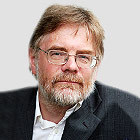Arrival City: How the Largest Migration in History is Reshaping the World
Doug Saunders
Heinemann, 2010
Humanity, that most adaptable of species, is on the march. The hunter-gatherers who became farmers are now halfway down the road from being agriculturalists to urbanites. Arrival City brilliantly captures the breakneck pace of this "great migration", as the peasants of the poor world relocate to their own megacities – and ours. And it brings profoundly good news from the mean streets.
These migrants move in hope from field to favela. Their new urban streets may not be paved with gold, but at least they are sometimes paved. They offer opportunity. And while disaster may await, life in the city is usually better, more healthy, more interesting and with a better chance of advancement. We should welcome the newcomers.
Doug Saunders, a Canadian journalist skilled in both colourful reportage and sustaining a good argument, provides a badly needed progressive and optimistic narrative about our future. This is the perfect antidote to the doom-laden determinism of the last popular book on urbanisation, Mike Davis‘s Planet of Slums. While Davis produced a relentless cascade of terrifying facts, Saunders offers people, their hopes and dreams and triumphs. His story is rooted not in statistics but in the stories of some of the two billion people – a third of humanity – currently moving from rural to urban areas.
He maps a world of "arrival cities", the places where new migrants end up. They are often seen as fetid social sinks, drowning in people and their excretions. But Saunders sees them as the bubbling soup from which new opportunities are born. From Brick Lane in London to the back streets of Dhaka; from newly gentrified Watts in Los Angeles to burgeoning Istanbul, he finds not hellholes, but a rich brew of aspiration, entrepreneurship and impromptu social organisation.
These migrants are not passive victims. They are opportunists, taking a gamble on the future in an urbanising world. They are humanity at its best, not worst. So we meet Sanjay in Mumbai, who shares a bare concrete floor with three other men, so he can send his meagre earnings as a street hawker home to his family in rural Maharashtra. Then there’s Pedro, brought up in a gang-ridden São Paulo slum, known only a decade ago as the most violent place on earth. He now lives a middle-class life of espresso bars, internet surfing and private schooling for the kids, in an apartment on the same street where the gangs once dumped the bodies of their victims.
This may be the best popular book on cities since Jane Jacobs‘s The Death and Life of Great American Cities half a century ago. Certainly, it shares the same optimism about human aspiration amid overcrowded buildings and unplanned urban jungles, and the same plea for planners to help rather than stifle those dreams.
To that end, Saunders sees "high-intensity" living – overcrowding, in the words of most planners – as a key to success in arrival cities. It encourages the cheap housing, business start-ups, social networking and sheer spontaneity that are key to taking the next step up.
Things don’t always work out. When suburban neighbours turn their backs, the results can be frightful. He says the unmet demands of migrants in arrival cities triggered both the Islamic fundamentalist revolution in Iran in 1979 and Hugo Chávez’s populist Bolivarian revolution in Venezuela a decade later.
But he finds numerous models for success, too. In Chongqing and Rio de Janeiro; in the thriving economies being built out of notorious slums such as Dharavi in Mumbai and Orangi in Karachi; in the rise of Britain’s Bangladeshi migrants, which has enabled them to send money home to Sylhet, where the big new houses in the villages are known as Londoni houses.
This is the final century of global urbanisation. We can, Saunders believes, harness the optimism and drive of the new urban arrivals to make this last great migration "a force for lasting progress, an end to poverty, a more sustainable economy, a less brutal existence". This requires us to understand and embrace the migration, investing in the arrival cities and offering some common humanity in a good cause.
To those who see urban migrants as totems of soaring world population, he says cities are the places where rural peasants, accustomed to raising large families to work in the fields, learn the virtues of having fewer kids and getting them educated. Arrival cities are actually where the world’s population stops growing.
To those who fear millions more poor migrants arriving in the rich world, he argues that we need them for their skills, youth and energy. As Europe’s indigenous populations shrink and age, what future do we have without Brazilian waiters and Eritrean fruit-pickers, Mexican barbers and Indian academics and Philippine nurses?
To those who want to tear down migrants’ slums, he says we should protect them instead. Few books can make rationalists feel optimistic and empowered for the future. This one does.
Fred Pearce’s Peoplequake is published by Eden Project.
Copyright © Guardian News and Media Limited 2010
